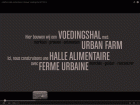
S.A. Abattoir is developing the entire site – part of which has heritage classification – of the Anderlecht Abattoirs, with support from the European Regional Development Fund (ERDF). We paid a visit to see how the work is going…
***
2014-11-25 – In front of the Anderlecht Abattoirs, if you look at the entrance to the famous covered market, a huge, late 19th-century metal building with heritage classification, you will notice cranes in action on the left (see video opposite on the left). They are in the process of erecting the concrete arches of what will be the new food hall. This will host butcher’s and greengrocer’s shops open to the public. To this project, partly funded by the European Regional Development Fund (ERDF) and the Brussels-Capital Region, should be added another building which will have shops on the ground floor and housing above. This part of the overall plan will rely on different funding arrangements and partnerships. However, the two projects are linked by the ambition to open the site entrance to the Chaussée de Mons and the metro station in the immediate vicinity: Clémenceau.
Just for once, European ERDF funds have thus gone to a public limited company, S.A. Abattoir. Its plan is modern and ambitious: it takes full account of the site’s location in Anderlecht, in the district between the Canal and the Chaussée de Mons, andfocuses on the needs of the local population, in the spirit of urban development in Brussels.
Enormous weekend market
Construction engineer Jo Huygh is responsible for managing the development of the Abattoir site. He stresses the overall character of the projects that will be structured around the Abattoir. ‘A master plan has been devised to examine the different site development possibilities in the direction of the Chaussée de Mons and the Rue Ropsy-Chaudron, and towards the Canal and the ErasmusUniversityCollegewhich is just behind the site. All in harmony with the occupants and inhabitants of these areas.’
Paul Thielemans, public relations officer at Abattoir, explains: ‘We’re a small urban slaughterhouse, and we want to retain this urban character. Our ambition is to serve the Brusselsregion with quality products. Proximity and artisanal production are very important to us.’
The slaughterhouse may be ‘small’, but the site is large and the activities that take place there are numerous. The weekend market, which runs from Friday to Sunday, hosts 650 traders and attracts some 100,000 visitors in three days. This is a great place for meeting friends, shopping and going for a walk. Though primarily for locals, it attracts people from the whole of Brussels.
The first stage of the master plan therefore involves the construction, at the end of the year 2014, of the food hall. The concrete forms which are going up give an initial idea of the unusual, rather oriental-looking shape of the windows on the different floors. The work should be completed by May 2015. The space will then be divided into an area for meat vendors and an area for vegetable vendors, with easy access for customers via the Chaussée de Mons. On the Rue Ropsy-Chaudron side will stand a bistrot-brasserie where shoppers can have a rest after their exertions.
In the second phase, if the new ERDF funding materialises, another urban warehouse will be built on the opposite side of the site, between the large central hall and the Canal. This will host a new slaughterhouse to replace the current one – not necessarily larger, but more economical, sustainable and open to the public, including students... ‘The educational side is also important for us,’ stresses Paul Thielemans. Guided tours could even be arranged there. This slaughterhouse will be combined with other food businesses in an overall project called ‘Manufakture Abattoir’.
Developing urban agriculture
These two warehouses are also united by very modern architectural designs. Flat roofs will be used to develop urban agriculture. ‘We even looked at a fish breeding project that could have been put on a roof,’ adds Paul Thielemans. For the sake of a comprehensive, environmentally friendly approach, S.A. Abattoir already processes and sorts its waste, including from the weekend market. The company is also considering discontinuing the use of plastic bags at some point in the future.
The projects are also part of an urban, short supply-chain approach: why not produce as close as possible to the point of consumption? This is certainly Abattoir’s ambition: producing locally for a local public. The multicultural quality of this district of Anderlecht has also been taken into account and will be reflected and harnessed.
S.A. Abattoir is encouraging entrepreneurship, but the company also wants to offer inspiration and is therefore looking for partners to develop other activities on the site. For example, the vaulted cellars of Cureghem may have useful spaces for basement vegetable-growing.
In Anderlecht, an entire district is changing: one that was originally dedicated to the processing and sale of meat, but that is now diversifying. And that is part of the major development in progress throughout the Canal Area.
Jean-Pierre Borloo
More information:
- S.A. Abattoir: www.abatan.be
- Boeremet: www.boeremet.be































